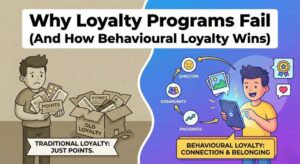How to diagnose and redesign early lifecycle journeys using behavior mapping
The welcome journey is one of the most important moments in a customer’s lifecycle. It sets the tone for your brand, helps users take their first steps toward value, and influences whether they stick around — or quietly disappear.
But here’s the reality: many brands invest heavily in acquisition and then leave their welcome journey running on autopilot. When it doesn’t deliver results, they simply add more emails or tweak subject lines — often without diagnosing the underlying issue.
In this post, we break down how to identify when your welcome journey isn’t working, why it may be failing, and how to fix it using a behavior-mapping approach.

Signs Your Welcome Journey Isn’t Working
Before you fix it, you need to know it’s broken. Here are a few signals that your early lifecycle journey needs attention:
- Low open or click-through rates: If your welcome emails aren’t being read or acted upon, it’s a sign the content or timing isn’t resonating.
- Early drop-off before key milestones: Look at what happens after someone signs up — are they completing their profile, making a first purchase, or simply vanishing after sign-up?
- High churn in the first 7–14 days: If customers are disappearing soon after joining, it’s time to reassess what you’re delivering in those crucial early touchpoints.
Why Generic Welcome Journeys Fail
Many welcome journeys fail because they treat all new customers the same — a one-size-fits-all approach that ignores intent, context, and behavior.
Here’s why generic approaches often underperform:
- Overloading users with irrelevant information: A typical welcome series often contains a flood of information — company history, product catalog, loyalty programs — but lacks focus.
- Ignoring acquisition source differences: Someone who signs up after reading a product review may need very different content than someone who signed up via a discount ad.
- Too many or too few touchpoints: Some brands send five emails in five days; others go silent after the first “Welcome” note. The cadence itself needs careful design.
Diagnosing the Problem: Behavior Mapping Basics
To fix a welcome journey that isn’t working, you first need to understand actual customer behavior in those early days — not assumptions about what they should do.
Behavior mapping is a simple but powerful technique that helps you diagnose drop-offs by looking at what users actually do after signing up.
Key steps:
- Map actual user actions in the first 7 days: Track events like email opens, website visits, browsing behavior, cart activity, and purchase attempts.
- Identify common drop-off points: Do users browse but not add to cart? Do they abandon after visiting certain pages? Pinpoint where interest fades.
- Segment by acquisition source or cohort: Behavior varies significantly depending on how users arrive. Someone from a referral may behave differently than a paid ad lead.
This map will help you design a journey that responds to behavior, rather than guessing what works.
Key Fixes to Redesign Your Welcome Journey
Once you understand where drop-offs occur, you can take action. Here’s what to focus on:
- Segment by intent
Don’t treat every user the same. Some may already have high intent to purchase; others need education. Adjust your content, offers, and CTAs to match where they are in their journey. - Reduce noise
Keep communications focused and purposeful. Avoid overwhelming new users with too many links, product recommendations, or calls to action. Make it easy for them to take the next logical step. - Introduce micro-conversions
Your ultimate goal may be a purchase, but smaller actions build momentum: browsing categories, saving favorites, downloading your app, subscribing to a newsletter. Reward these behaviors and guide users forward. - Adjust channel mix and cadence
Your users may not all prefer email. Use SMS or WhatsApp for key nudges if they engage better on those platforms — but be mindful of frequency. Test and refine cadence until you find the right balance between helpful and intrusive.
Measuring Success After Redesign
A redesigned welcome journey needs to be measured carefully to ensure that improvements deliver real impact.
Key metrics to monitor include:
- Activation rate: Are more new users completing a key first milestone (e.g., profile completion, first purchase)?
- Retention rate at Day 7, Day 14, Day 30: Short-term retention is the clearest indicator of welcome journey health.
- Engagement rate: Are users opening, clicking, browsing, and interacting more as a result of your changes?
Set benchmarks and monitor regularly — the welcome journey is not a set-it-and-forget-it process.
Common Mistakes to Avoid
As you redesign your welcome journey, watch out for these pitfalls:
- One-size-fits-all content: Remember that acquisition source, user behavior, and timing all matter.
- Relying solely on email: If you’re not using channels your customers prefer (such as WhatsApp or push notifications), you may miss opportunities to engage.
- Ignoring silent churners: If users aren’t opening or engaging with your journey at all, they may need a different intervention — or an earlier exit from the sequence.
Final Thoughts
Your welcome journey is one of your most critical lifecycle stages. It’s not just about sending a few friendly emails — it’s about guiding new customers toward value quickly and efficiently, before they drop off or disengage.
At ConSoul, we help brands go beyond generic templates by diagnosing customer behavior, mapping journeys accurately, and building lifecycle programs that reduce drop-off, improve retention, and drive measurable growth.
If your welcome journey isn’t delivering the results you expect, the solution isn’t to send more emails — it’s to design smarter, behavior-driven experiences.



